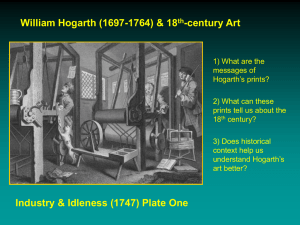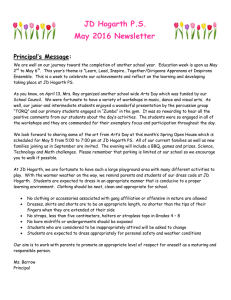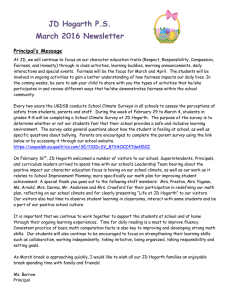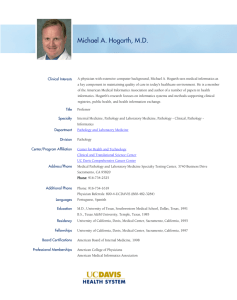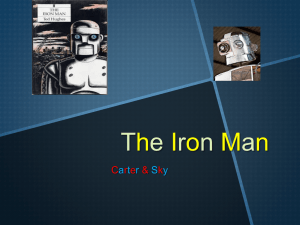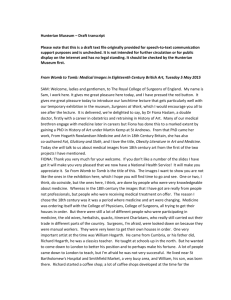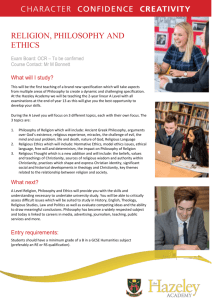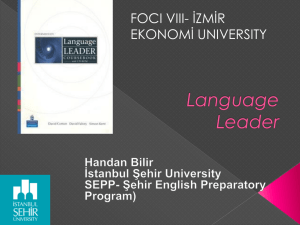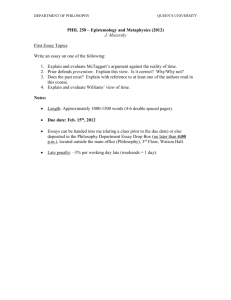University of Kent at Canterbury
advertisement
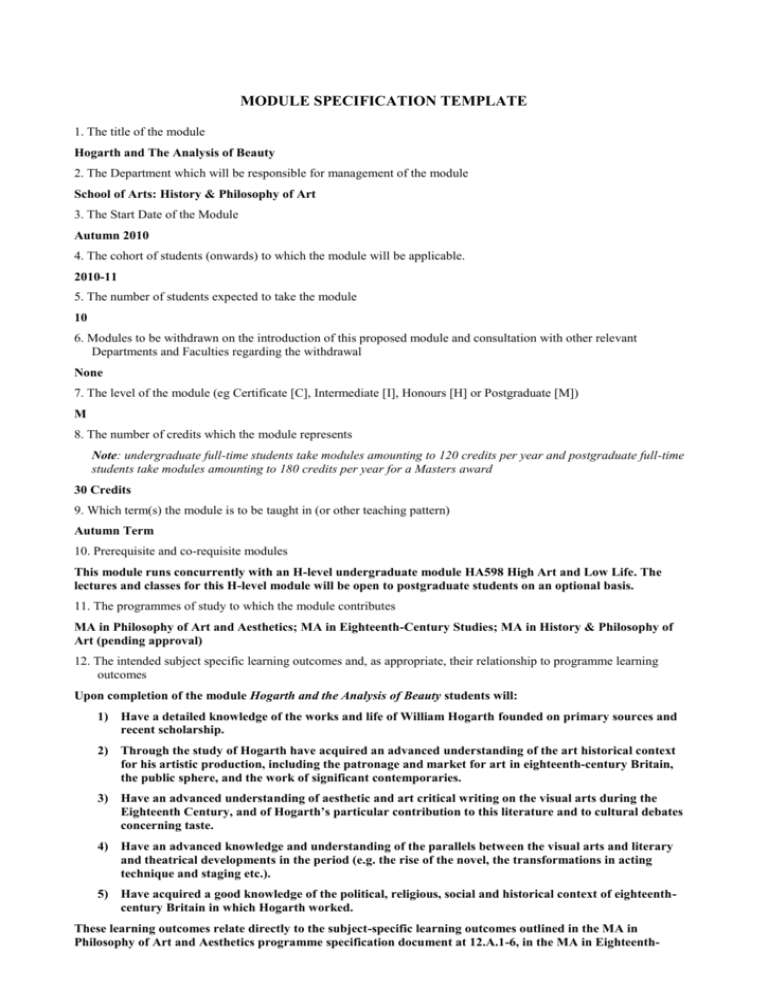
MODULE SPECIFICATION TEMPLATE 1. The title of the module Hogarth and The Analysis of Beauty 2. The Department which will be responsible for management of the module School of Arts: History & Philosophy of Art 3. The Start Date of the Module Autumn 2010 4. The cohort of students (onwards) to which the module will be applicable. 2010-11 5. The number of students expected to take the module 10 6. Modules to be withdrawn on the introduction of this proposed module and consultation with other relevant Departments and Faculties regarding the withdrawal None 7. The level of the module (eg Certificate [C], Intermediate [I], Honours [H] or Postgraduate [M]) M 8. The number of credits which the module represents Note: undergraduate full-time students take modules amounting to 120 credits per year and postgraduate full-time students take modules amounting to 180 credits per year for a Masters award 30 Credits 9. Which term(s) the module is to be taught in (or other teaching pattern) Autumn Term 10. Prerequisite and co-requisite modules This module runs concurrently with an H-level undergraduate module HA598 High Art and Low Life. The lectures and classes for this H-level module will be open to postgraduate students on an optional basis. 11. The programmes of study to which the module contributes MA in Philosophy of Art and Aesthetics; MA in Eighteenth-Century Studies; MA in History & Philosophy of Art (pending approval) 12. The intended subject specific learning outcomes and, as appropriate, their relationship to programme learning outcomes Upon completion of the module Hogarth and the Analysis of Beauty students will: 1) Have a detailed knowledge of the works and life of William Hogarth founded on primary sources and recent scholarship. 2) Through the study of Hogarth have acquired an advanced understanding of the art historical context for his artistic production, including the patronage and market for art in eighteenth-century Britain, the public sphere, and the work of significant contemporaries. 3) Have an advanced understanding of aesthetic and art critical writing on the visual arts during the Eighteenth Century, and of Hogarth’s particular contribution to this literature and to cultural debates concerning taste. 4) Have an advanced knowledge and understanding of the parallels between the visual arts and literary and theatrical developments in the period (e.g. the rise of the novel, the transformations in acting technique and staging etc.). 5) Have acquired a good knowledge of the political, religious, social and historical context of eighteenthcentury Britain in which Hogarth worked. These learning outcomes relate directly to the subject-specific learning outcomes outlined in the MA in Philosophy of Art and Aesthetics programme specification document at 12.A.1-6, in the MA in Eighteenth- Century Studies programme specification document at 12.A.1-5, and in the MA in History & Philosophy of Art programme specification document at 12.A.1-9. 13. The intended generic learning outcomes and, as appropriate, their relationship to programme learning outcomes Upon completion of the module Hogarth and the Analysis of Beauty students will 1) have developed to an advanced level skills of critical reading and analysis of a range of primary and secondary texts, including visual materials. 2) have developed to an advanced level the key skills of written communication, problem solving, and have attained responsibility for their own learning. 3) have used relevant Information Technologies to research and present their work. 4) have developed to an advanced level the key skills of oral communication and working with others in a group, as well as gaining confidence in participating in critical discussion and debate while remaining open to the viewpoints of others. 5) have advanced in their use of relevant learning and reference resources (including visual resources) within the Templeman Library and the internet, and have used them effectively to support their arguments and analyses. 6) have improved their ability to write coherent, informed and logical arguments in a well-organised and well-presented essay. These learning outcomes relate directly to the generic learning outcomes and transferable skills outlined in the MA in Philosophy of Art and Aesthetics programme specification document at 12.B.1-7, 12.C.1-6 and 12.D.1-6, in the MA in Eighteenth-Century Studies programme specification document at 12.B.1-5, 12.C.1-4 and 12.D.1-9, and in the MA in History & Philosophy of Art programme specification document at 12.B.1-6, 12.C.1-6 and 12.D.1-5. 14. A synopsis of the curriculum This M level History & Philosophy of Art module is designed to contribute simultaneously to three Humanities programmes as an optional module: the MA in Philosophy of Art and Aesthetics, the MA in Eighteenth-Century Studies and the MA in History & Philosophy of Art (currently going through the approval process). It is designed to be a versatile and interdisciplinary module that pursues intellectual links across the Faculty’s research culture through the study of the visual arts within eighteenth-century culture, and how they responded to developing capitalist markets and rapidly changing social structures and belief systems. The module focuses closely on the exemplary figure of William Hogarth. An innovative society portraitist, and an admirer of academic artists like Sir James Thornhill and Jonathan Richardson, Hogarth aspired like them to elevate British painting to the status of ‘High Art’ (e.g. his altarpiece for St. Mary Redcliffe in Bristol). However, Hogarth was also a shrewd entrepreneur who exploited the print medium to develop new forms of art with a contemporary critical edge aimed at a middle-class ‘public’: the ‘modern moral subject’ and ‘comic history painting’. Although he parodied snobbish and affected taste, especially for imported foreign trends (opera, fashion, art collecting), Hogarth’s comedy had a serious moral purpose comparable to the writings of contemporary novelists like Samuel Richardson and Henry Fielding. Through close study of Hogarth’s works – for example, the series ‘A Harlot’s Progress’ (1731/2), ‘A Rake’s Progress’ (1735), ‘Marriage à-la-Mode’ (1745) and ‘Industry and Idleness’ (1747) – the module will examine the cultural exchange between Britain and the continent, the links between art, theatre and literature, and also the material culture, social conditions, and political and ideological structures of life in eighteenth-century Britain. In particular it will examine Hogarth’s characteristic contribution to philosophical debates around aesthetics ‘The Analysis of Beauty’ (1753), and its relation to other key aesthetic texts of the period such as the ‘Discourses’ of Joshua Reynolds and Edmund Burke’s ‘A Philosophical Enquiry into the Sublime and the Beautiful’. 15. Indicative Reading List David Bindman, Hogarth: Serious Comedy, exhibition catalogue, 1997. Mark Hallett and Christine Riding, Hogarth, exhibition catalogue, 2006. William Hogarth, The Analysis of Beauty, 1753. Ronald Paulson, Hogarth, 3 vols, 1992-93. Robin Simon, Hogarth, France and British Art, 2007. Jennifer Uglow, Hogarth: A Life and a World, 1997. 16. Learning and Teaching Methods, including the nature and number of contact hours and the total study hours which will be expected of students, and how these relate to achievement of the intended learning outcomes The module will be taught by means of a weekly two hour seminar (adding up to 20 timetabled contact hours). These will broadly divide into lectures given by the module convenor, seminar discussions on primary texts, and student presentations on Hogarth prints in the Kent Print Collection. During reading weeks there will be trips to London to view works by Hogarth, for example, at the Soane Museum, the National Gallery, and the Foundling Hospital. Postgraduate students taking this module will be free to attend the classes running for the related undergraduate module HA598 High Art and Low Life. For a 30 credit module students should do at least 300 hours of study, the bulk of which will consist of private study guided by reading lists and handouts. These teaching methods are designed to deliver the subject specific and generic learning outcomes outlined at 12.1-5 and 13.1-6. 17. Assessment methods and how these relate to testing achievement of the intended learning outcomes Assessment will be by an essay of up to 5000 words on a topic chosen from those defined by the tutors or by the student in agreement with tutors. The assessment will measure knowledge, research effort and ability, critical acuity, the relevance and organisation of material, linguistic sophistication and quality of presentation. All these qualities are closely related to subject-specific and generic learning outcomes outlined at 12.1-5 and 13.1-6. 18. Implications for learning resources, including staff, library, IT and space The Templeman Library is already well-stocked with books supporting this module, while the Kent Print Collection has a number of original prints by William Hogarth and his contemporaries that will support teaching and learning for this course. 19. A statement confirming that, as far as can be reasonably anticipated, the curriculum, learning and teaching methods and forms of assessment do not present any non-justifiable disadvantage to students with disabilities The teaching methods and forms of assessment do not present any non-justifiable disadvantage to students with disabilities. Any trips organised for the module will ensure disabled access.
